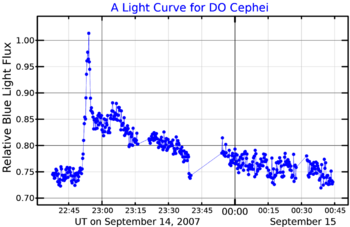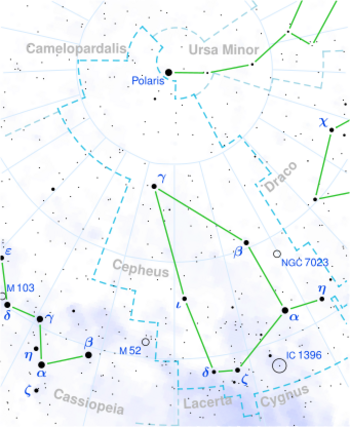Astronomy:Kruger 60
Coordinates: ![]() 22h 27m 59.4677s, +57° 41′ 45.150″
22h 27m 59.4677s, +57° 41′ 45.150″
| Observation data {{#ifeq:J2000|J2000.0 (ICRS)|Epoch J2000.0 Equinox J2000.0 (ICRS)| Epoch J2000 [[Astronomy:Equinox (celestial coordinates)|Equinox J2000}} | |
|---|---|
| Constellation | Cepheus |
| Krüger 60 A | |
| Right ascension | 22h 27m 59.55755s[2] |
| Declination | +57° 41′ 42.0806″[2] |
| Apparent magnitude (V) | {{{appmag_v1}}} |
| Krüger 60 B | |
| Right ascension | 22h 27m 59.79560s[3] |
| Declination | +57° 41′ 49.7468″[3] |
| Apparent magnitude (V) | {{{appmag_v2}}} |
| Characteristics | |
| Spectral type | M3V/M4V[4] |
| Variable type | None/Flare star |
| Astrometry | |
| Krüger 60 A | |
| Proper motion (μ) | RA: −725.227±0.537[2] mas/yr Dec.: −223.461±0.348[2] mas/yr |
| Parallax (π) | 249.3926 ± 0.1653[2] mas |
| Distance | 13.078 ± 0.009 ly (4.010 ± 0.003 pc) |
| Absolute magnitude (MV) | 11.76 |
| Krüger 60 B | |
| Proper motion (μ) | RA: −934.098±1.319[3] mas/yr Dec.: −686.244±1.410[3] mas/yr |
| Parallax (π) | 249.9668 ± 0.7414[3] mas |
| Distance | 13.05 ± 0.04 ly (4.00 ± 0.01 pc) |
| Absolute magnitude (MV) | 13.46 |
| Details | |
| Krüger 60 A | |
| Mass | 0.271[5] M☉ |
| Radius | 0.35[6] R☉ |
| Metallicity | –0.04[7] |
| Krüger 60 B | |
| Mass | 0.176[5] M☉ |
| Radius | 0.24[6] R☉ |
| Luminosity | 0.0034[citation needed] L☉ |
| Temperature | 2,890[citation needed] K |
| Orbit[8] | |
| Primary | Krüger 60 A |
| Companion | Krüger 60 B |
| Period (P) | 44.67 yr |
| Semi-major axis (a) | 2.383″ |
| Eccentricity (e) | 0.410 |
| Inclination (i) | 167.2° |
| Longitude of the node (Ω) | 154.5° |
| Periastron epoch (T) | 1970.22 |
| Argument of periapsis (ω) (primary) | 211.0° |
| Other designations | |
| Database references | |
| SIMBAD | The system |
| A | |
| B | |
Location of Krüger 60 in the constellation Cepheus | |
Krüger 60 (DO Cephei) is a binary star system located 13.1 light-years (4.0 parsecs) from the Sun. These red dwarf stars orbit each other every 44.6 years.
Description
The larger, primary star is designated component A, while the secondary, smaller star is labeled component B. Component A has about 27% of the Sun's mass and 35% of the Sun's radius. Component B has about 18% of the Sun's mass and 24% of the Sun's radius.[5][6] Component B is a flare star and has been given the variable star designation "DO Cephei".[10] It is an irregular flare that typically doubles in brightness and then returns to normal over an 8-minute period.[citation needed]
On average, the two stars are separated by 9.5 AUs, which is roughly the average distance of Saturn from the Sun. However, their eccentric mutual orbit causes their distance to vary between 5.5 AUs at periastron, to 13.5 at apastron.[citation needed]
This system is orbiting through the Milky Way at a distance from the core that varies from 7–9 kpc with an orbital eccentricity of 0.126–0.130.[11] The closest approach to the Sun will occur in about 88,600 years when this system will come within 1.95 parsecs.[12]
Considering the orbit of the members of Krüger 60, detecting an exoplanet through radial velocity could prove difficult, as its orbit would be inclined only 13 degrees from our point of view, and create 1/5th as strong a radial velocity signal as an exoplanet orbiting edge-on from the point of view of the Solar System.
Origin of 2I/Borisov
Krüger 60 was proposed as the origin of interstellar comet 2I/Borisov (formerly named C/2019 Q4 (Borisov)) in a preprint submitted to arXiv by Dybczyński, Królikowska, and Wysoczańska.[13] These authors had from other work a list of stars and stellar systems that can potentially act as perturbers of the Oort cloud comets, and searched it for a past close proximity of 2I/Borisov at a very small relative velocity. While hampered by uncertainty about the orbit of 2I/Borisov and particularly its non-gravitational acceleration (due to cometary outgassing), they initially reached a conclusion that 1 Myr ago 2I/Borisov passed Krüger 60 at a small distance of 1.74 pc while having an extremely small relative velocity of 3.43 km/s. Perturbations of 2I/Borisov's incoming orbit altered the intersection distance with relatively small changes in the relative velocity. However, further study by the same authors presented in the revised version of the preprint instead ruled out the possibility of Krüger 60 as a home system for 2I/Borisov.[13]
See also
References
- ↑ Dal, H. A. (July 2020). "The flare cumulative frequencies of UV Ceti stars from different spectral types". Monthly Notices of the Royal Astronomical Society 495 (4): 4529–4541. doi:10.1093/mnras/staa1484. Bibcode: 2020MNRAS.495.4529D. https://ui.adsabs.harvard.edu/abs/2020MNRAS.495.4529D. Retrieved 6 December 2021.
- ↑ 2.0 2.1 2.2 2.3 2.4 Brown, A. G. A. (August 2018). "Gaia Data Release 2: Summary of the contents and survey properties". Astronomy & Astrophysics 616: A1. doi:10.1051/0004-6361/201833051. Bibcode: 2018A&A...616A...1G. Gaia DR2 record for this source at VizieR.
- ↑ 3.0 3.1 3.2 3.3 3.4 Brown, A. G. A. (August 2018). "Gaia Data Release 2: Summary of the contents and survey properties". Astronomy & Astrophysics 616: A1. doi:10.1051/0004-6361/201833051. Bibcode: 2018A&A...616A...1G. Gaia DR2 record for this source at VizieR.
- ↑ Henry, Todd J. (October 1994). "The solar neighborhood, 1: Standard spectral types (K5-M8) for northern dwarfs within eight parsecs". The Astronomical Journal 108 (4): 1437–1444. doi:10.1086/117167. Bibcode: 1994AJ....108.1437H.
- ↑ 5.0 5.1 5.2 Delfosse, Xavier et al. (December 2000), "Accurate masses of very low mass stars. IV. Improved mass-luminosity relations", Astronomy and Astrophysics 364: 217–224, Bibcode: 2000A&A...364..217D
- ↑ 6.0 6.1 6.2 Pasinetti Fracassini, L. E. (February 2001). "Catalogue of Apparent Diameters and Absolute Radii of Stars (CADARS) - Third edition - Comments and statistics". Astronomy and Astrophysics 367 (2): 521–524. doi:10.1051/0004-6361:20000451. Bibcode: 2001A&A...367..521P. The data is from the Vizier II/224 catalogue.
- ↑ Bonfils, Xavier; Delfosse, Xavier; Udry, Stéphane; Santos, Nuno C.; Forveille, Thierry; Ségransan, Damien (2005). "Metallicity of M dwarfs. I. A photometric calibration and the impact on the mass-luminosity relation at the bottom of the main sequence". Astronomy and Astrophysics 442 (2): 635–642. doi:10.1051/0004-6361:20053046. Bibcode: 2005A&A...442..635B. http://cdsads.u-strasbg.fr/cgi-bin/nph-bib_query?2005A%26A...442..635B&db_key=AST&nosetcookie=1. Only listed for component A.
- ↑ Heintz, W. D. (August 1986). "Orbits of 20 visual binaries". Astronomy and Astrophysics Supplement Series 65 (2): 411–417. Bibcode: 1986A&AS...65..411H.
- ↑ "NSV 14168 – Variable Star". SIMBAD. Centre de Données astronomiques de Strasbourg. http://simbad.u-strasbg.fr/simbad/sim-basic?Ident=NSV+14168.
- ↑ White, Stephen M. (December 1989). "A VLA survey of nearby flare stars". Astrophysical Journal Supplement Series 71: 895–904. doi:10.1086/191401. Bibcode: 1989ApJS...71..895W.
- ↑ "The galactic orbits of nearby UV Ceti stars". Revista Mexicana de Astronomía y Astrofísica 34: 37–46. 1998. Bibcode: 1998larm.confE.115A.
- ↑ García-Sánchez, J. (November 2001). "Stellar encounters with the solar system". Astronomy and Astrophysics 379 (2): 634–659. doi:10.1051/0004-6361:20011330. Bibcode: 2001A&A...379..634G.
- ↑ 13.0 13.1 Dybczyński, Piotr A.; Królikowska, Małgorzata; Wysoczańska, Rita (24 September 2019). "Kruger 60 as a home system for 2I/Borisov -- a case study". arXiv:1909.10952 [astro-ph.EP].
Further reading
- James B. Kaler (22 March 2001). Extreme Stars: At the Edge of Creation. Cambridge University Press. p. 31. ISBN 978-0-521-40262-0. https://books.google.com/books?id=3kcjvYLh8xIC.
External links
 |



